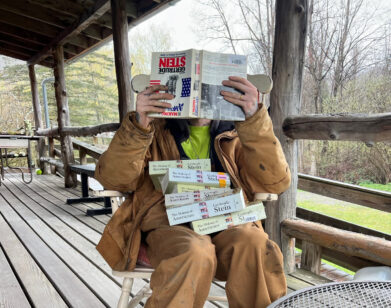Of Lilies, Monarchs, and Wayfarers

ABOVE, FROM LEFT: ERIC MARX, LISLE RICHARDS. PHOTOGRAPH BY FRANK SUN.
The Monarch, Gilded Lily, The Wayfarer–the names evoke something like a fairytale rather than Manhattan’s newest hotspots. But they’re the latter, created by two men who’ve forged their way to the vanguard of New York’s scene: nightlife and dining powerhouses Eric Marx and Lisle Richards, partners with a combined two decades plus in the business.
The wistful decadence of the monikers is no accident. Marx and Richards devised a lavish pastiche of old Manhattan. “We talked a lot about the return to New York City glamour,” offers Richards, who often brings up the ’20s and ’70s, the most chic of decades, as overarching inspirations. With a sincere elegance, their venues are a break from a certain staged grit that’s been dominating on the warehouse party circuit.
Most recently opened is the The Wayfarer, which at first glance slinks with the leather allure of Mad Men. Exploring further guests will spot Brigitte Bardot’s coquettish pout, rendered in shadows with black paint near a raw bar. The space is rounded off with disco-era touches: photographs of a fab Diana Ross, young Jack Nicholson, and a bowling Richard Nixon (why not?) decorate the walls. Attached to midtown’s Quin Hotel, Wayfarer serves classic American fare during the day. That includes lots of seafood and some quality brunch pastries baked in-house. At night it transforms into a dim retro lounge, lending parties a smoky after-hours charisma. Designed by Meyer Davis Inc., it has the sort of unpretentious energy that kept Shailene Woodley dancing far past midnight at the Divergent premiere after-party.
Last fall, Marx and Richards debuted Meatpacking’s Gilded Lily club below The Monarch Room restaurant. Milk Studios nearby brought about a string of hit Fashion Week parties. Things spiraled upwards from there–it’s now frequented by downtown’s creative elite. Roman and Williams designed the interior, which evokes a sort of Great Gatsby spirit, if Jay lived in a highly refurbished industrial edifice. Encasing the golden ornamentations are cement walls, left intact from when the building was a parking garage.
Marx and Richards paths’ crossed when they worked in the same building–Richards upstairs at the ONE Group, known for STK, and Marx downstairs at EMM Group, which operates SL. Both started out low on the hospitality totem pole–Marx as a kitchen intern; Richards as a waiter–and toiled (partied) their way up to director of operations and vice president, respectfully.
One night in 2010, the two went out to dinner. “Do you want to open a restaurant?” someone uttered. Whoever the suggestion came from–they were each thinking it–the idea put them in motion. “[It went from] ‘It could happen,’ then, ‘It should happen,’ and turned into ‘It may actually happen,’ then ‘It will happen,’ and now, it has happened,'” says Richards. They left their respective companies in 2011 and set about finding a space.
We met them at The Wayfarer, a couple blocks from Central Park, and they insisted we try a raved-about avocado toast plate (it was delicious).
SMALL: The Wayfarer has a retro flair, and many distinct details that echo vintage elements. How did it come about?
RICHARDS: We talked a lot about people’s homes. I think that in New York you don’t get enough of a chance to entertain in your home. I think that weaves through in the design.
SMALL: How did you become interested in hospitality?
RICHARDS: I’ve done everything there is to do in a restaurant. Hospitality is one of those industries that you learn from inside out. I fell in love with it because [I like] taking care of people. Engaging in hospitality is something that has a real grace to it. I moved to New York to do photography. [But] all my life I waited tables, or bartended, or hosted, or managed. I woke up one day and realized that it was more than a job; it could be a career.
SMALL: Did you make connections trying out photography that helped you start in hospitality?
RICHARDS: It’s not a question of connections. It’s a question of outlook. It’s all the same kind of pot. It’s creating an experience for a guest. It’s the same thing if you’re in a photo shoot: you’re painting a picture. You engage in that same sort of creative activity, in making a comfortable atmosphere. That’s the food, that’s the uniforms, that’s the service style, that’s the lighting, that’s the music, you know? It’s a whole composition. It’s painting a backdrop for somebody’s evening. It’s part of the same [sphere of] creative endeavors.
SMALL: What do you want people to feel when they enter, say, the Monarch Room?
RICHARDS: I think there’s definitely a sense of arrival. It’s a grand experience. It’s a grand kind of experience you know when you walk in. You walk through there’s this great marble room that you’ve seen. When you cross that next set of doors, it kind of opens up into this other.
SMALL: The night is beginning, there are surprises in store.
RICHARDS: People want to go out there, they want to have fun, they want to show up.
SMALL: That’s very ’70s glam, I feel.
RICHARDS: Monarch is more like ’20s.
MARX: ’20s mixed with ’50s.
RICHARDS: Those are times in New York when people really kind of went out and had dinner and they–
MARX: –made an experience out of it.
SMALL: What have been some of your favorite reactions to it?
RICHARDS: Ian Schrager had his holiday event at Monarch Room. He told us that we have a big hit on our hands.
SMALL: Can you tell me more about the drink program?
MARX: There’s certain glasses for certain cocktails. We try to find some glasses that have some style to it or some character to it so that it makes the overall experience feel even more special.
RICHARDS: Some of them are crushed ice. Some of them are cubed ice. Some have the big, you know…
SMALL: [laughs] All the ice shapes.
MARX: The whole mixology program is in-house.
SMALL: How did you meet the mixologist?
MARX: The mixologist, Christian Sanders, we met in our travels. I worked with him years and years ago. Then I came across him again and started drinking his cocktails and talked to him about doing his cocktails with us.
SMALL: And the more cocktails you drank, the more appealing he seemed as a great mixologist.
MARX: Yeah, exactly! [laughs] No, I brought friends to his bar downtown to see what their opinion was. During the tasting, I brought big groups of people so I made sure that it wasn’t just my taste buds that enjoyed his cocktails. Definitely stumbled out of there a few nights…
SMALL: Eric, what were your first experiences in hospitality like?
MARX: Well, I got experience working in the bowels of a kitchen–doing prep work and cleaning. Perfection is what the chef wanted to present to his customers and I think that still lies with me. [But] I enjoyed being in the front of the house. I still love creating and cooking but I really prefer the front of the house more. I’m a people person. I like talking to people and taking care of people. It’s hard doing that when you’re stuck in the kitchen, stuck on a line.
SMALL: Now that it’s all come together, are there any details you’re particularly proud of?
MARX: I love the tablecloths.
RICHARDS: Oh, the tablecloths! Oh, the napkins! I’m proud of the napkins.
SMALL: How did you find the first spaces, for Gilded Lily and Monarch?
MARX: We looked at a lot of spaces.
RICHARDS: [laughs] We looked at every space in New York. Big spaces, small spaces, Bowery. Flatiron.
MARX: In 2010, a longtime friend of mine found this space [a parking garage, to become Monarch and Gilded Lily] and we walked in and we felt the energy. We were like, ‘This is the right space for something that we want to do.’ [It had] good bones. Good architecture. It had a lot of old New York in there, a lot of history.
RICHARDS: Back in the early ’80s, there was an after-hours party for Studio 54 there. We were like, ‘I think this actually might be meant to be.’ It was an after-hours party called Crisco Disco. And the DJ booth was this big, massive Crisco can, which is amazing.
SMALL: Going back to the Wayfarer, why did you emphasize classic American?
RICHARDS: We talked a lot about all the brasseries, we talked about American cuisine. There’s this really kind of great all-day brasserie feel to it, which I think has worked out very well. There’s red meat choices, there’s fish choices, there’s a great brunch.
[In general], we do all the work so that people don’t have to do the work. We put all of this love into it, so people can just come in and have a great meal. They don’t have to think about why it was so good.
SMALL: Where do you see these spaces standing within New York nightlife and dining? Where do they fit in?
RICHARDS: They’re all fresh alternatives. I think that there’s a real opportunity within the dining scene to do something that people haven’t seen in a while. New Yorkers eat out every night of the week so I think there’s more of that community. I think from our discussions, pre-opening and opening, we just want to create spaces that are comfortable for people and well thought out.
MARX: We want to stay here for a while.
THE WAYFARER, GILDED LILY, AND THE MONARCH ARE ALL OPEN NOW.






